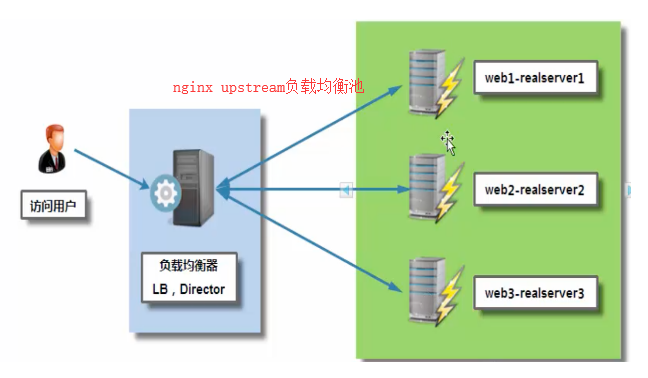集群
概念:
大白话就是:一堆服务器做一件事
一组若干个相互独立的计算机,利用高速通信网络组成一个较大的计算机服务系统,每个集群节点都是运行各自服务的独立服务器。
存在地方:可能分布在全国各地。(有点夸张了,全国各地那这个服务系统超级大了)比如谷歌,淘宝,百度服务器,背后估计有成千上万台电脑组成多个集群干多件事情
为什么要用集群?
单点计算机很难达到高性能的特点。
高性能、价值有效性、可扩展性:如果当服务负载压力增加时,就可以对系统进行扩展,且不会降低服务质量 高可用性:挂了单点计算机,其它的计算机还可以正常工作7*24
负载均衡
平均分配压力(压力均摊)
负载均衡抽象理解(图糙理不糙)


小黄人好酷,分担压力泽帅


实验准备
准备三台计算机 当然我这里无法真正上的测试哈!两台还好计算机还好能扛下来,三台有点难。
nginx1 作为nginx负载均衡器 假如ip为192.168.13.121
nginx2 web服务 提供一个简单的页面 192.168.13.24
nginx3 web服务 提供一个简单的页面 192.168.13.79
主要是配置负载均衡器,要看效果的话可以配置下web服务两个的首页
1 #user nobody; 2 worker_processes 1; 3 4 #error_log logs/error.log; 5 #error_log logs/error.log notice; 6 #error_log logs/error.log info; 7 8 #pid logs/nginx.pid; 9 10 11 events { 12 worker_connections 1024; 13 } 14 15 16 http { 17 include mime.types; 18 default_type application/octet-stream; 19 20 #log_format main '$remote_addr - $remote_user [$time_local] "$request" ' 21 # '$status $body_bytes_sent "$http_referer" ' 22 # '"$http_user_agent" "$http_x_forwarded_for"'; 23 24 #access_log logs/access.log main; 25 26 sendfile on; 27 #tcp_nopush on; 28 29 #keepalive_timeout 0; 30 keepalive_timeout 65; 31 32 #gzip on; 33 upstream mchotdog{ 34 # 默认我给它轮询算法 35 server 192.168.13.79; 36 server 192.168.13.24; 37 } 38 server { 39 listen 80; 40 41 server_name 192.168.13.121; 42 43 #charset koi8-r; 44 45 #access_log logs/host.access.log main; 46 47 location / { 48 proxy_pass http://mchotdog; 49 # root html; 50 # index index.html index.htm; 51 } 52 53 #error_page 404 /404.html; 54 55 # redirect server error pages to the static page /50x.html 56 # 57 error_page 500 502 503 504 /50x.html; 58 location = /50x.html { 59 root html; 60 } 61 62 # proxy the PHP scripts to Apache listening on 127.0.0.1:80 63 # 64 #location ~ .php$ { 65 # proxy_pass http://127.0.0.1; 66 #} 67 68 # pass the PHP scripts to FastCGI server listening on 127.0.0.1:9000 69 # 70 #location ~ .php$ { 71 # root html; 72 # fastcgi_pass 127.0.0.1:9000; 73 # fastcgi_index index.php; 74 # fastcgi_param SCRIPT_FILENAME /scripts$fastcgi_script_name; 75 # include fastcgi_params; 76 #} 77 78 # deny access to .htaccess files, if Apache's document root 79 # concurs with nginx's one 80 # 81 #location ~ /.ht { 82 # deny all; 83 #} 84 } 85 86 87 # another virtual host using mix of IP-, name-, and port-based configuration 88 # 89 #server { 90 # listen 8000; 91 # listen somename:8080; 92 # server_name somename alias another.alias; 93 94 # location / { 95 # root html; 96 # index index.html index.htm; 97 # } 98 #} 99 100 101 # HTTPS server 102 # 103 #server { 104 # listen 443 ssl; 105 # server_name localhost; 106 107 # ssl_certificate cert.pem; 108 # ssl_certificate_key cert.key; 109 110 # ssl_session_cache shared:SSL:1m; 111 # ssl_session_timeout 5m; 112 113 # ssl_ciphers HIGH:!aNULL:!MD5; 114 # ssl_prefer_server_ciphers on; 115 116 # location / { 117 # root html; 118 # index index.html index.htm; 119 # } 120 #} 121 122 }
最好先测试下再启动nginx

1 调度算法 2 轮询 按时间顺序逐一分配到不同的后端服务器(默认) 3 weight 加权轮询,weight值越大,分配到的访问几率越高 4 ip_hash 每个请求按访问IP的hash结果分配,这样来自同一IP的固定访问一个后端服务器 5 url_hash 按照访问URL的hash结果来分配请求,是每个URL定向到同一个后端服务器 6 least_conn 最少链接数,那个机器链接数少就分发
在这里可以看下我主配置文件解读的配置比较全面